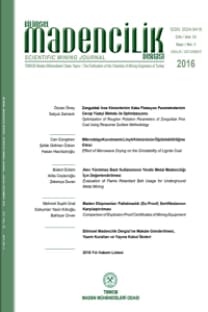KUZEYBATI ANADOLU HALLOYSİT VE KAOLENLİ HALLOYSİT CEVHERLERİ ZENGİNLEŞTİRME ÇALIŞMALARI
Kuzeybatı Anadolu’da Çanakkale-Balıkesir Bölgeleri içinde kalan bazı halloysit ve halloysitli kaolen
yataklarının yüksek alan şiddetli yaş manyetik ayırım ve özütleme yöntemleri ile zenginleştirmeleri
araştırılmıştır. Birincil kirlilik kaynağı olan limonitlerin uzaklaştırılmasında en etkili işlemin özütleme
olduğu, ancak ince taneli muskovitin ortamdan uzaklaştırılamadığı düşünülmektedir. Özütlemede
organik ve inorganik asitler araştırılmış, her iki asidin de başarılı olduğu bulunmuştur. Özütleme işleminde
en önemli parametrenin sıcaklık olduğu (80 °C), düşük sıcaklıkta (25 °C) yüksek asit derişimlerinde
bile ayırım yapılamadığı anlaşılmıştır. Kinetik testler, organik bir asit olan oksalik asidin çalışılan
her cevherde daha etkili ve daha hızlı bir çözücü olduğunu göstermiştir. TEM analizleri ile halloysit
numunesinin nanometre boyuttaki tanelerinin özütleme ile bozunmaya uğramadıkları belirlenmiştir
Anahtar Kelimeler:
Halloysit, kaolen, zenginleştirme, özütleme, manyetik ayırım
Beneficiation Studies of Halloysite and Halloysite/Kaolinite Ores from Northwestern Anatolia
In this study concentration of halloysite and halloysite/kaolin ores from northwestern Anatolia was
investigated by wet high intensity magnetic separation and acid leaching methods. It was found that
the acid leaching is the most effective method for the removal of primary coloring impurities such as
limonite. However it is considered that fine grained muscovite cannot be removed from the ores even in
the highest acid concentrations. In the leaching tests organic and inorganic acids were tested and both
of them are found successful. It was concluded that temperature (80 °C) is the most critical parameter
in acid leaching of iron from the ores since the separation could not be performed in the highest acid
concentrations at low temperature (25 °C). It was realized that oxalic acid is more effective in terms
of leaching kinetics and acid consumption. The morphology of raw ore and leaching concentrates of
the halloysite samples were examined and compared by TEM analyses. It is understood that acid
treatment process has no obvious effect on tubular structures
Keywords:
Halloysite, kaolen, beneficiation, leaching, magnetic separation,
- ISSN: 2564-7024
- Yayın Aralığı: Yılda 4 Sayı
- Yayıncı: TMMOB Maden Mühendisleri Odası
Sayıdaki Diğer Makaleler
KARIŞTIRMALI VE KOLON BİYOLİÇİ YÖNTEMLERİ İLE KOLEMANİT CEVHERİNDEN BORİK ASİT ÜRETİMİ
KUZEYBATI ANADOLU HALLOYSİT VE KAOLENLİ HALLOYSİT CEVHERLERİ ZENGİNLEŞTİRME ÇALIŞMALARI
Saruhan SAKLAR, Ş. Levent ERGÜN, Özcan Y. GÜLSOY
GEDİKLER (EŞME, UŞAK) BENTONİTİNDEN DEMİRİN UZAKLAŞTIRILMASI
Hatice YILMAZ, Uğur KÖKTÜRK, Gül AKAR
